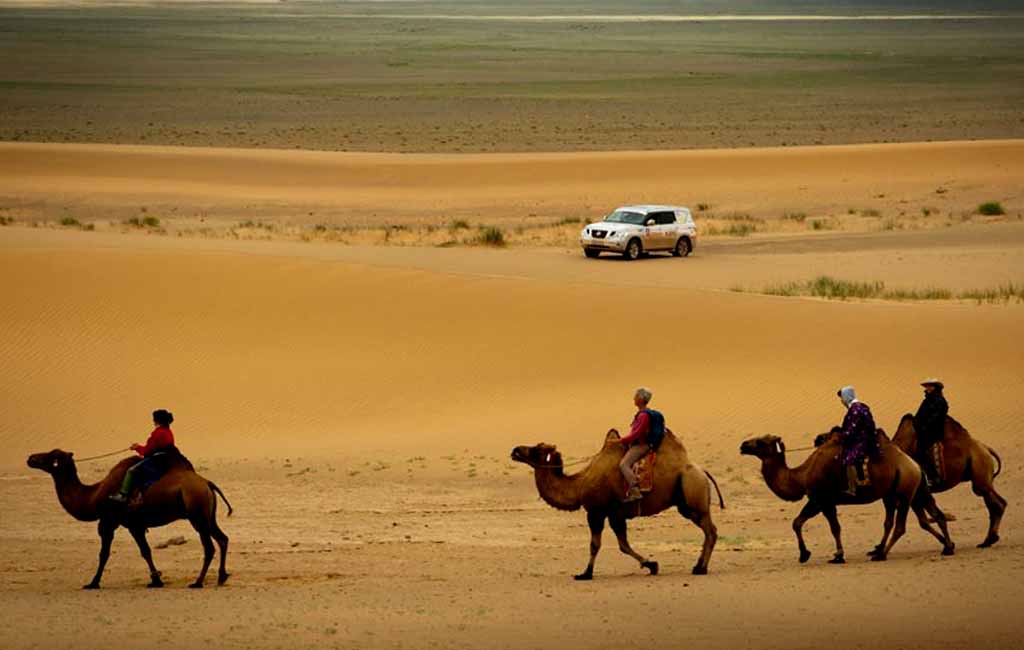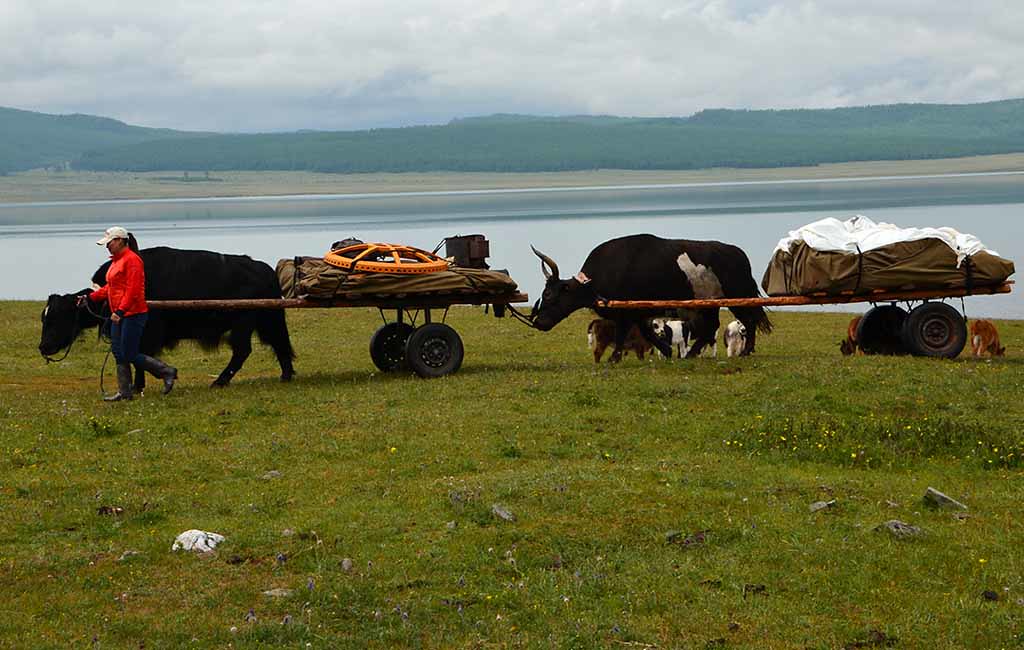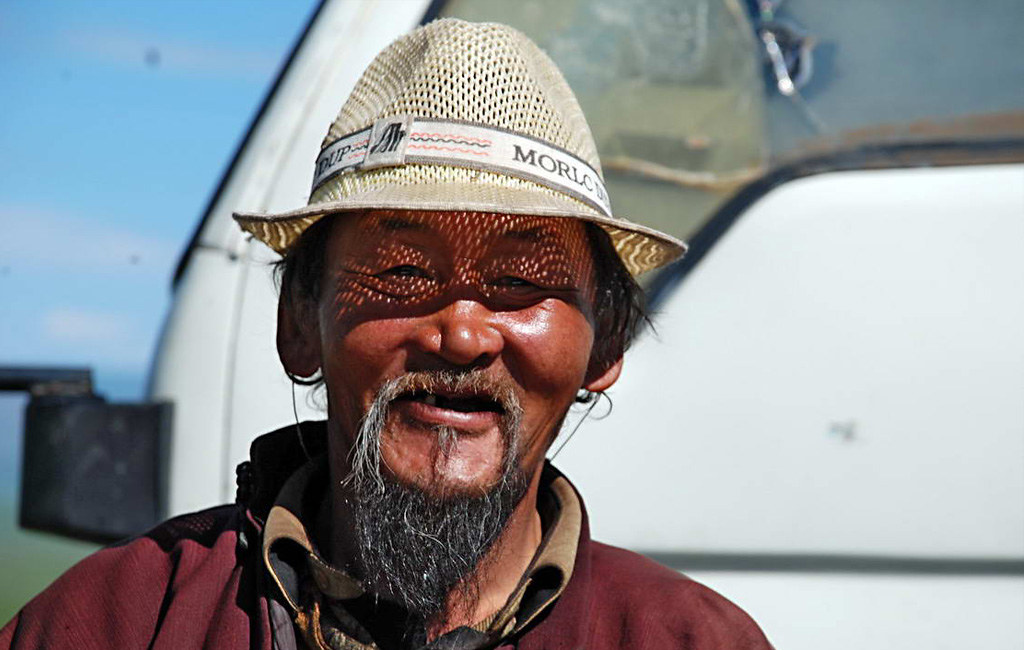Nomadic Voyages (17 days / 16 nights)
- Region:
- Southern, Central &
Northern part of Mongolia - Duration:
- 17 days / 16 nights
- Dates:
- May 10-26, June 16 – July 2, July 21 – Aug 6,
Aug 14-30, Sep 6-22 - Note:
- You can arrange your own trip date (with best rate possible) as you request
- Number of travelers:
- Min - 2, Max - 18
Single Supplement: $550
If you are traveling alone and wish to share accommodations, we will try to match you with a roommate.
BOOK TRIP CUSTOMIZE THIS TOUR What is Ger Camp? DOWNLOAD ITINERARY AS A PDF
Quick inquiry
Day 1 Arrive Ulaan Baatar & City Tour
Day 2 Moron / Hovsgol Lake
Day 3 Hovsgol Lake Hiking and Wildlife
Day 4 Moron to Ulaan Baatar
Day 5 Fly to the Gobi Desert (1.2 hours) and drive to Yol Valley and Gurvan saikhan National Park
Day 6 Drive to Khongor sand dune
Day 7 Khongor Sand Dune
Day 8 Khongor sand dunes to Bayanzag (Flaming Cliffs)
Day 9 Day trip to Khavtsgait Petroglyphs and Nomad day
Day 10 Bayanzag to Ongi Temple
Day 11 Ongi temple to Karakorum (Erdenezuu monastery)
Day 12 Karakorum (Erdenezuu monastery) to Tuwkhun Monastery
Day 13 Tuwkhun Monastery to Tsenher Hot Spring
Day 14 Tsenher Hot Spring to Elsensen Tasarkhai via Ugii Lake
Day 15 Elsensen Tasarkhai to Hustai National park
Day 16 Ulaan Baatar: Bogdo Khaan Winter Palace
Day 17 Departure
Price: $2998 for per personSingle Supplement: $550
If you are traveling alone and wish to share accommodations, we will try to match you with a roommate.
| Included | Not included |
| Private ger for every 2 people in Ger camp | International airfare |
| All meals as listed in itinerary | Travel insurance |
| All entrance fees | Beverages |
| Sightseeing as per itinerary | Optional activity cost |
| Accommodation in 4 stars hotel in Ulaanbaatar (twin standard room double occupancy) | Excess baggage charge |
| Transportations by 4WD vehicles | Single room supplement |
| English speaking guide (other language guide on request) | Any additional things which are not mentioned above |
| Daily supply of bottled water | |
| Cultural Show | |
| Internal flight |
Day 1 Arrive Ulaanbaatar & City Tour
Arrive in Ulaan Baatar and transfer to your centrally located hotel. Enjoy an evening tour of Ulaan Baatar city, including the War Memorial at Zaisan if time permits. Rest of the day is for rest and to recover jet lag and travel fatigue. The first stop is at Sukhbaatar Square, which is the central square named after the revolutionary hero of 1921 Damdiny Sukhbaatar whom declared independence from China. You will visit the Gandan Monastery that is the largest and most famous functioning monastery in Mongolia; here you may experience the monks in worship and see the impressive Golden Buddha Statue of Migjid Janraisig. Time permitting you can visit the Natural History Museum which is famous for its authentic dinosaur skeletons and also visit the Zaisan memorial hill to get a fantastic view of whole city. You will have a welcome dinner at local restaurant.
Meals: Dinner
Lodging: 4 star hotel
Day 2 Moron / Hovsgol Lake
After an early breakfast at the hotel, fly into Moron, the center of the Hovsgol province. From Moron, you will be driven to the base camp at Lake Hovsgol (approx. 70 miles). With an area of 1,012 sq. miles lying near the Russian border, Hovsgol is Mongolia’s largest freshwater lake. It is more than 800 feet deep and more than a mile above sea level. The remainder of the day is at your leisure. Overnight at the camp
Meals: Breakfast, Lunch, Dinner
Overnight in the Ger Camp
Day 3 Hovsgol Lake Hiking and Wildlife
After breakfast at the camp you will have a full day to explore the breathtaking shores of this beautiful
lake. There is ample opportunity to discover the local nomadic lifestyle. You can plan hiking and photo
ventures along the shorelines, which are excellent habitats for wildlife and birds.
Walking and hiking in the lake shores, Horse riding trek near the lake, visiting yak breeding family and
experience their unique lifestyle
Meals: Breakfast, Lunch, Dinner
Overnight in the Ger Camp
Day 4 Moron to Ulaan Baatar
Drive to airport after breakfast. Take the flight back to Ulaanbaatar and transfer to hotel.
Rest of the day is for rest and dinner at local restaurant in Ulaanbaatar.
Meals: Breakfast, Lunch, Dinner
Overnight in 4 star hotel
Day 5 Fly to the Gobi Desert (1.2 hours) and then drive to Yol Valley and Gurvan saikhan National Park
In the morning, we drive to airport for flight to Gobi, one of the most famous and exotic areas in the world. The Gobi occupies about one-third of Mongolia and consists of sand dunes and dry mountain ranges. As one of the harshest environments on earth with extreme temperature and seasonal changes, the Gobi is surprisingly full of wildlife such as white and blacktail gazelles, wild ass or “hulan” in Mongolian, wild camel or “havtgai”, antelopes, ibex, and argali sheep, the biggest wild sheep on the planet. The majority of Mongolia’s population of bactrian camels live in this area, and you can take a camel ride if you like. Upon arrival, transfer to the base camp at the Gobi. You may visit the Yol Valley National Park for a morning trek with opportunities to photograph the stunning landscape, “Gobi Glacier”, and intriguing wildlife.
Overnight: Gobi Nomad Lodge, Deluxe Ger with en-suite bathroom with shower and air conditioning
Meals: Breakfast, lunch and dinner
Day 6 Drive to Khongor sand dune
Today we will drive to Khongorinn Els sand dunes, the largest sand dunes in Mongolia. These dunes lie in the Gobi Gurvan Saikhan National Park. The drive is through some incredible desert scenery with flat, stony plains; outcrops of vegetation; hills of interesting rock formations; and herds of wild antelope racing across the plains. The roads are flat and fairly even so it will take at least 4 hours. The shifting sand blown by the wind or someone makes sound so it is called Singing Sand Dunes.
Overnight in Ger Camp,
Meals: Breakfast, lunch and dinner
Day 7 Khongor Sand Dune
Today we will have a full day exploring the sand dunes and rest after the long drive. The dunes seem to stretch on forever like a soft ribbon of sand draped over the desert. The shifting sand blown by the wind or someone makes sound so it is called Singing Sand Dunes. There is a beautiful green oasis known as Seruun bulag near the Khongor River. Return to the camp for lunch and enjoy feeling silence and a peaceful in the beautiful surroundings Gobi Deserts.
Overnight in the Ger Camp
Meals: Breakfast, lunch and dinner
Day 8 Khongor sand dunes to Bayanzag (Flaming Cliffs)
Drive to Bayanzag which is located 20 kilometers far from Bulgan soum, where 70 million years ago a lot of Paleontological findings have been discovered. The place is known as Flaming Cliffs so named by Roy Chapman Andrews American explorer who had visited Mongolia in 1922. During two years he searched through the Mongolian Gobi Desert and he found dinosaur fossils and dinosaur eggs about 10-15 cm from the Bayanzag for the first time in the world. Visiting and exploring native land of dinosaurs and taking some photos for beautiful surroundings.
Overnight: Gobi Nomad Lodge, Deluxe Ger with en-suite bathroom with shower and air conditioning
Meals: Breakfast, lunch and dinner
Day 9 Day trip to Khavtsgait Petroglyphs and Nomads day
In the morning we drive to the site of the Khavtsgait Petroglyphs. The Khavtsgait Petroglyphs from the Bronze
Age (4000-3000 BC) are beautifully carved on many rocks on the top of a sacred mountain. It is easy to find
the rock paintings there because they are spread on rocks all around. The area is very rocky and can be
slippery to climb, but by carefully following a path up the mountain, you can reach the top to see these
beautiful rock paintings.
The petroglyphs were carved and painted with motifs consisting of animals, hunting scenes and weapons. They
depict various animals related to everyday life of ancient people including deer, bears, wolves and hunters,
and wolves with livestock. Other paintings depict more domestic scenes of yaks pulling carts, the wheels and
horses flattened sideways like hieroglyphs, and herders on horseback. The engravings vary in size, ranging
from two-centimeters to the real life size of horses.
After the rest, we will visit a herder family nearby. We will spend some time there getting to know the
family members and their casual yet unique daily lifestyle. It is a good chance to see how the family
members cooperate together to do their daily even hourly chores such as milking mares, fencing and milking
the goats. If you wish, you are welcome to try some mare's fermented milk and other dairy products.
Overnight: Gobi Nomad Lodge, Deluxe Ger with en-suite bathroom with shower and air conditioning
Meals: Breakfast, lunch and dinner
Day 10 Bayanzag to Ongi Temple
Drive to Ongi temple. The ruins of Ongi Temple are found in Saikhan Ovoo soum of Dundgobi (Middle Gobi) province. It used to be a big Buddhist monastery compound built by Bari Yonzon Khamba at the bank of Ongi River. Transfer to the camp before the lunch. Visit the ruins of temple also there is small ger museum signifies ancient things.
Overnight in the Ger Camp
Meals: Breakfast, lunch and dinner
Day 11 Ongi temple to Karakorum (Erdenezuu monastery)
Early morning drive to Karakorum and arrive late afternoon, on the way picnic. Ancient capital of Mongolia Karakorum city was located on the right bank of Orkhon River and on the north-eastern slopes of the Khangai Mountain and founded by Chinggis khan in 1220, was not only the capital of the vast Mongolian Empire but the epicentre of trade along the Silk Road. At that time the inhabitants of city were mostly Merchants craftsmen who came to karakorum from all over the world. Khubilai khan moved to the capital of the Mongolian Empire to China, establishing the Yuan Dynasty, began losing its importance. In 1379 much of the city was badly damaged during an attack by the army of the Min Dynasty.
Erdene Zuu monastery
Erdene zuu monastery was built by Avtai Sain Khan on the ruin of the Mongolian capital Karakorum in
1586. It was the first great Buddhist Monastery of Mongolia. It is part of the World Heritage Site entitled
Orkhon Valley Cultural Landscape. Stones from the ruins of Karakorum were used in construction. It is
surrounded by a wall featuring 108 stupas, 108 being a sacred number in Buddhism, and the number of beads in
a Buddhist rosary. The monastery was damaged by warfare in the 1680s, but was rebuilt in the 18th century
and by 1872 had a full 62 temples inside. The Erdene Zuu Monastery was taken to state protection and became
museum in 1944.
Overnight in the Ger Camp
Meals: Breakfast, lunch and dinner
Day 12 Karakorum (Erdenezuu monastery) to Tuwkhun Monastery
In the morning, we drive to Tuwkhun monastery which is founded by Zanabazar. This attractive landscape is
registered as WORLD HERITAGE PLACE from UNESCO.
Tuvkhun Monastery
The creation work temple established by Undur Gegeen Zanabazar in 1654 dedicated to religious study and
art works became the foundation of today’s Tuvkhun Monastery. It is located on a rocky mountain hill
surrounded by forests elevated in 2300 meters above sea level. In 1651, the first religious statesman
Zanabazar built a small stony building and he created Soyombo letters in the building. The monastery is
located in natural rocky landscape where there is a small cave named “Mother’s abdomen”. The Mongols still
protect this unique place as naming it as a “Country of Mahagal”. These monuments were created during the
war between Khalkh and Uuld and the Door of Great Pleasure is a tunnel dug through the mountain. During the
war the Under Gegeen escaped through this tunnel and intentionally closed the hole by a big stone. The
monastery was taken under the state protection in 1992.
Overnight in Ger Camp
Meals: Breakfast, lunch and dinner
Day 13 Tuwkhun Monastery to Tsenher Hot Spring
Following breakfast at tourist camp, we will drive to Tsenher hot spring. Along the way we will stop for a break in the small town of Tsetserleg to visit a monastery museum. We spend overnight in a ger camp based at natural hot springs. Soak in hot water; enjoy a hike in the hills.
Overnight in Ger Camp,
Meals: Breakfast, lunch and dinner
Day 14 Tsenher Hot Spring to Elsensen Tasarkhai via Ugii Lake
In the morning drive to Ugii Lake. On the way we will be visiting two monuments of Turkish and about 60 kilometers from the imperial town of Karakorin. There are two important monoliths located near another one. The first monument is dedicated to the Turkish prince Kul-Tegin (638-731), and the other to his brother Bilge-Khan (716-734). After lunch, we drive to Elsen tasarkhai. On the way visit nomad family, exploring how do they live in yurt, how do they make diary product, chance to take some picture and attempt to drink fermented mare’s milk.
Overnight in Ger Camp
Meals: Breakfast, lunch and dinner
Day 15 Elsensen Tasarkhai to Hustai National park
Drive to Hustai National Park Hustai National Park is the site of a unique re-introduction scheme of Przewalskii’s horse (Equus przewalskii), called "takhi" by Mongolians. It became extinct in the wild in 1969 and, since 1992, has been successfully re-introduced to Hustai from zoos around the world. This has been an international effort monitored by The Foundation for the Przewalskii Horse, based in the Netherlands and MACNE (Mongolian Association for Conservation of Nature and the Environment). The national park is rolling Steppe Mountains with rather large patches of birch and aspen forests. There are also visible remains of Neolithic graves. In addition, red deer (Cervus elaphus) and wolf (Canis lupus) have increased quite a bit during the last few years, as well as Mongolian gazelle. Species present in Hustai but usually not seen include Lynx, Argali Sheep and Roe Deer.
Overnight in the Ger Camp
Meals: Breakfast, lunch and dinner
Day 16 Ulaan Baatar: Bogdo Khaan Winter Palace
After breakfast, we will drive to Ulaanbaatar and transfer to hotel. Visit the Bogd Khaan Winter Palace Museum. The Bogdo Khaan Winter Palace is the home of the last Mongolian King, Javzun Damba Khutagt VII. The museum contains a number of Buddhist artworks and the private collection of Bogdo Khaan, composed of gifts from rulers and kings from all over the world. The artworks displayed here were made by the top Mongolian, Tibetan, and Chinese master-sculptors of the 18th and 19th centuries and represent the gods of Buddhist pantheon. In the afternoon free time do shopping for cashmere shop, souvenir shop and State Department Store. Enjoy watch national folklore performance by “Tumen Ekh” national song, throat singing, tsam mask dance and so on. A farewell dinner and stay overnight in hotel.
Meals: Breakfast, Lunch, Dinner
lodging: 4 star hotel
Departure
Check out from the hotel and transfer to the “Chinggis Khan” International airport for departure.
Meals: Breakfast
Single Supplement: $550
If you are traveling alone and wish to share accommodations, we will try to match you with a roommate.
| Included | Not included |
| Private ger for every 2 people in Ger camp | International airfare |
| All meals as listed in itinerary | Travel insurance |
| All entrance fees | Beverages |
| Sightseeing as per itinerary | Optional activity cost |
| Accommodation in 4 stars hotel in Ulaanbaatar (twin standard room double occupancy) | Excess baggage charge |
| Transportations by 4WD vehicles | Single room supplement |
| English speaking guide (other language guide on request) | Any additional things which are not mentioned above |
| Daily supply of bottled water | |
| Cultural Show | |
| Internal flight |
All airport transfers and sightseeing will be by private cars, SUVs and mini bus. The arrival and departure transfers will be by Sedan Cars which are usually Japanese made Toyota or Honda cars. Sightseeing within Ulaanbaatar will be by an air conditioned minibus. Outside Ulaanbaatar, we provide 4WD Land cruisers or SUVs. There will be 3 to 4 travelers seated in a 4WD vehicle.











